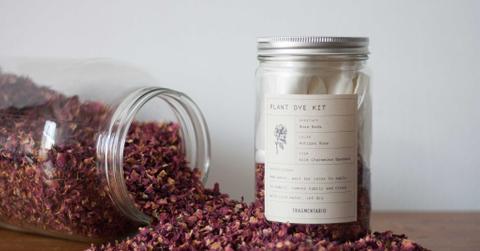Why Designers Are Using Fruits And Vegetables To Dye Their Clothes
We worry about the ingredients in our food—why not our clothes? That's the thinking behind Fragmentario, a natural dye company in Brooklyn, N.Y., that is part of a growing design trend in the fashion industry.
Updated May 21 2019, 5:04 p.m. ET
As a kid, I dabbled in tie-dye, with kits of what I realize now were most likely horrendously poisonous packets of color. But for all their toxicity, the colors did come out significantly more vibrant than when, later on, I experimented with a variety of flowers and leaves that did little more than to turn white fabric a dull, washed-out tan color. Which only teaches me that I should sign up ASAP for one of Maria Elena Pombo’s workshops.
The designer launched natural dye company Fragmentario in 2016 out of her studio in Bushwick, Brooklyn, where she also sells DIY dying kits and teaches workshops on how to use natural products to create gorgeous dyes for textiles and clothes. The success of those workshops has inspired her to expand her base to Europe, where throughout August and September she’s traveling through Spain and Italy to offer up her services. Fragmentario and other companies like it are indicative of a growing trend in fashion: the belief that what we put on our bodies should be as pure as what we put in them.
Chemical dyes are bad for the environment, not to mention your skin.
Synthetic dyes, which you’ll find on just about 100-percent of all the clothes you wear, are made out of chemical compounds that can harm people working in the manufacturing of those clothes, as well as create skin irritations on the wearer’s skin.
Waterways are also at put risk during the process of manufacturing synthetic dyes, where too often untreated dye effluent gets dumped (directly or indirectly) into bodies of water like rivers or lakes.
Natural dyes are actually really easy to work with.
Pombo told Mind Body Green she was shocked at how simple it was to use organic matter to lend gorgeous coloring to white fabrics. "We just tried with the onion skins first,” she said. “We placed some fabric in them and it was only a matter of hours before they were so vibrant."
Fruits and veggies such as those onion skins Pombo played around with, beet skins, spinach, orange peels, and red cabbage leaves can all make for beautiful, muted dyes for face paint, clothing, or even Easter eggs when the time comes.
Pombo is also a fan of using avocado pits to turn white fabric crimson, and color palettes offered by chamomile, hibiscus, and roses. Each of which, of course, won’t leach harmful chemicals right into your biggest organ: your skin.
The unpredictable nature of natural dyes is also part of their charm.
Of course, when you’re mixing beet skins to dye your white dress red, you never know exactly what hue you’re going to end up with. And that can certainly cause some designers anxiety, given that they may hope to recreate the same item or style again and again.
Not so with natural dyes. Even avocado pits will create different shades depending on where the fruit was grown—and water will always affect the final color.
“I think that right now, not a lot of people know about natural dyes, but I think in five years people will become more aware,” Pombo told Mind Body Green. “We ask so many questions about our food. Why shouldn't this be next?"
